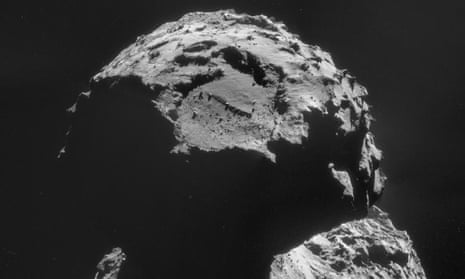The Guardian’s story “Philae comet could be home to alien life, say scientists” has been met with scepticism and outright dismissal by leading comet experts.
The people behind the headline are Chandra Wickramasinghe, University of Buckingham, and Max Wallis, University of Cardiff. Today, the Daily Mirror reported Wickramasinghe as saying, “Data from the comet seems to unequivocally point to micro-organisms being involved.”
However, the evidence for any life on Philae’s comet is flimsy at best. Even Wickramasinghe’s own colleague fell short of agreeing with him outright. At the academic lecture that triggered the story, Paul Sutherland of SEN reported Wallis as saying, “If there is any active biology in the comet, we’d hope to detect it”.
Certainly, the vast majority of comet scientists would agree that comet 67P’s surface features are much more easily explained by non-biological mechanisms.
“No scientist active in any of the Rosetta instrument science teams assumes the presence of living micro-organisms beneath the cometary surface crust,” Uwe Meierhenrich of Université Nice Sophia Antipolis, France, told me in an email exchange on Monday afternoon.
Meierhenrich serves as a co-investigator on Philae’s COSAC instrument, which was designed to chemically analyse the comet. He told me that a comet’s black surface crust was a prediction made in 1986 by J. Mayo Greenberg (Nature 321, 385), who calculated what would happen to naturally occurring organic molecules on the comet when they were struck by cosmic rays and light.
“These explanations seem to be valid, also with regard to new data of the cometary Rosetta mission,” wrote Meierhenrich.
Several of the news reports have quoted Wickramasinghe as saying that he was not allowed to place life detection equipment on the Philae lander. They go on to say that the spacecraft cannot detect life, even if it is there. This last assertion is simply not true.
Life is quite picky about which chemicals it utilises; therefore, if life were present on the comet, this would recognisably boost a number of key molecules. COSAC and the PTOLEMY instrument on Philae could measure this enhancement. “We can thereby well distinguish between the biological and astrochemical formation of organics,” wrote Meierhenrich.
A first list of molecules identified on the cometary nucleus by COSAC, authored by Meierhenrich and colleagues, will be published at the end of July in the journal Science. According to Meierhenrich, this list hints at non-biological formation mechanisms.
Wickramasinghe has a history of claiming to have detected extraterrestrial microbes. In 2001, he claimed to find extraterrestrial microbes in stratospheric dust collected at 41km in altitude. In 2003, he suggested that the SARS virus came from outer space. None of this work has been accepted by the mainstream.
However, an earlier hypothesis of Wickramasinghe’s that the molecular building blocks of life could have been brought to Earth by comets is now widely thought plausible. Evidence to back up this claim has been amassed by independent investigations, of which Rosetta and Philae are the latest round.
However, Wickramasinghe appears to see this acceptance as a weapon to be used against his bolder ideas. In a paper published in 2014, he wrote that the acceptance and promotion of this idea by scientific journals, “serves as a deliberately chosen device to keep the full force of evidence for ingress of extraterrestrial life from coming to the public’s notice.”
Today’s story began in a press release issued by the Royal Astronomical Society at 23:01 BST on Sunday 5 July. “Do micro-organisms explain features on comets?” ran the bold headline. It was to publicise a talk at the National Astronomy Meeting. However, the abstract of that talk mentions life only in passing.
Planetary scientist Professor Dave Rothery of the Open University posted in a comment on Facebook, “The Guardian and the RAS disgraced themselves today with the ‘top scientists’ argue case for life on comet’ piece today. I’ve just sat through the talk behind the press release and I think it fair to say that the audience was polite but entirely unconvinced. Diatoms [a type of micro-organism] in comets, my arse!”
Stuart Clark is the author of Is There Life on Mars? (Quercus). Follow him on Twitter.

Comments (…)
Sign in or create your Guardian account to join the discussion